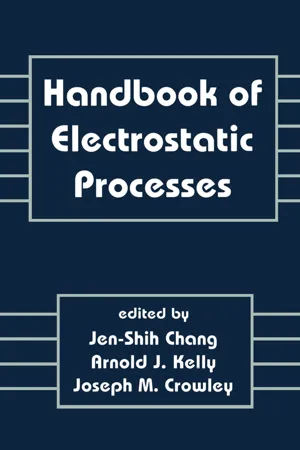
This is a test
- 768 pages
- English
- PDF
- Available on iOS & Android
eBook - PDF
Handbook of Electrostatic Processes
Book details
Book preview
Table of contents
Citations
About This Book
"Provides detailed, comprehensive descriptions of electrostatic processes as well as their applications in areas such as rheology, atomization and spraying, industrial dust particle precipitation and filtering, biomedical engineering, gas treatments, atmospheric electricity, chemical reactors, and electronic devices. Summarizes electrostatic fundamentals and electrical phenomena in solids and fluids."
Frequently asked questions
At the moment all of our mobile-responsive ePub books are available to download via the app. Most of our PDFs are also available to download and we're working on making the final remaining ones downloadable now. Learn more here.
Both plans give you full access to the library and all of Perlego’s features. The only differences are the price and subscription period: With the annual plan you’ll save around 30% compared to 12 months on the monthly plan.
We are an online textbook subscription service, where you can get access to an entire online library for less than the price of a single book per month. With over 1 million books across 1000+ topics, we’ve got you covered! Learn more here.
Look out for the read-aloud symbol on your next book to see if you can listen to it. The read-aloud tool reads text aloud for you, highlighting the text as it is being read. You can pause it, speed it up and slow it down. Learn more here.
Yes, you can access Handbook of Electrostatic Processes by Jen-Shih Chang, Arnold J. Kelly, Joseph M. Crowley in PDF and/or ePUB format, as well as other popular books in Technology & Engineering & Electrical Engineering & Telecommunications. We have over one million books available in our catalogue for you to explore.
Information
Electrostatic
Fundamentals
Joseph
M.
Crowley
Electrostatic
Applications
Morgan
Hill
,
California
1
I.
INTRODUCTION
Electrostatics
is
used
in
a
wide
range
of
applications
ranging
from
the
calculation
of
atomic
forces
to
wrapping
of
leftover
food
items.
All
of
these
applications
can
be
understood
by
the
application
of
a
few
principles
based
on
numerous
observations.
This
chapter
describes
these
principles
and
gives
the
formulas
used
to
calculate
the
magnitude
of
the
effects.
The
ideas
presented
here
will
be
used
repeatedly
in
the
later
chapters
to
discuss
particular
aspects
of
electrostatics.
II.
COULOMB’S
LAW
Electrostatics
is
based
primarily
on
the
observation
that
like
charges
repel
and
unlike
charges
attract,
as
indicated
in
Fig.
1.
The
force
is
observed
to
increase
linearly
with
each
of
the
two
charges,
so
that
(
1
)
The
magnitude
of
the
force
falls
off
quadratically
as
the
charges
are
sepa
rated,
so
the
force
expression
can
be
further
specified
as
(2)
1
Table of contents
- Cover
- Half Title
- Title Page
- Copyright Page
- Contents
- Preface
- Contributors
- 1 Electrostatic Fundamentals
- 2 Electrification of Solid Materials
- 3 Electrostatic Charging of Particles
- 4 Electrical Phenomena of Dielectric Materials
- 5 Flow Electrification of Liquids
- 6 Numerical Techniques for Electrostatics
- 7 Dimensionless Ratios in Electrohydrodynamics
- 8 Injection Induced Electrohydrodynamic Flows
- 9 Gas Discharge Phenomena
- 10 Generation of High Voltages
- 11 Measurement of Electrostatic Fields, Voltages, and Charges
- 12 Electrostatic Flow Measurement Techniques
- 13 Electrostatic Multiphase Flow Measurement Techniques
- 14 Printers
- 15 Electrophotography
- 16 Electrostatics in Flat Panel Displays
- 17 Applications of the Electrostatic Separation Technique
- 18 Electrostatic Coalescence in Liquid-Liquid System
- 19 Electrorheology
- 20 Electrostatic Atomization and Spraying
- 21 Electrostatic Precipitation
- 22 Modeling of Electrostatic Precipitators and Filters
- 23 Transducers
- 24 EHD Enhanced Mass Transfer Operations and Chemical Reactions
- 25 Heat Engineering
- 26 Ozone Generation and Applications
- 27 Combustion Flue Gas Treatments
- 28 Atmospheric Electricity
- 29 Biomedical Engineering
- 30 ESD Hazards in the Electronics Industry
- 31 Static Electricity Hazards: Solid Surfaces and Gases
- 32 Electrostatic Hazards During Liquid Transport and Spraying
- 33 Electrostatic Charge Elimination Techniques
- Index